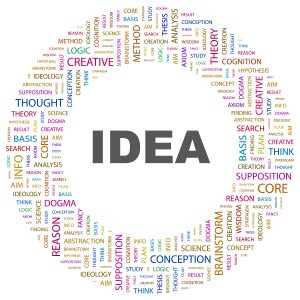3 Finding Your Focus
Presenting facts and information with a human spin
It’s literally true that every person asked the right questions has an interesting story to tell. Don’t narrow the possibility of what a story can be.
Steve Rushin
It can’t be easy to be a journalism student.
For four years in high school, you were taught to write essays containing a thesis statement, utilizing parenthetical citations to attribute material.
 Then you come into your journalism education classes, and we teach you the most important information comes first, as per the summary lede of an inverted pyramid story, and all facts are now cited through speaker attribution.
Then you come into your journalism education classes, and we teach you the most important information comes first, as per the summary lede of an inverted pyramid story, and all facts are now cited through speaker attribution.
And don’t worry about the end of your article — the inverted pyramid says just finish it off with the least important information.
Then, we tell you, “Hold on — don’t put the most important information first. Now you can craft a narrative story at the beginning of your article, and the most important information should come a graph or two (or five) down in the form of a nut graph — the story in a nutshell. And the body should entice the reader to consume the whole story until they get to a beautifully crafted conclusion.
What is a writer to do?
The most important facet of being a student of journalism is to realize that there are a place and time for every type of article, and your versatility will help you be even more marketable.
Hard news articles have their place. They are written so readers can get the information they need immediately and stop reading at any time, and still come away with the whole story. This is different from a feature, sometimes described as “soft news,” which is written to encourage the audience to stick around to the end, so that the climax comes at the end.
Becoming Familiar with Features
There are a lot of terms for what we are seeking to produce: piece, feature, article, story, narrative. But ultimately the form for all is the same: nonfiction written in journalistic form utilizing:
- Research
- Interviews
- Facts
- Quotes
News writing utilizes all of these pieces, but that is not what we are crafting.
We are creating feature articles
What is feature writing?
Feature writing is relating facts and information with a more narrative style, using fiction-writing techniques, including characters, descriptions, anecdotes, scene-setting and dialogue.
This version of nonfiction goes beyond simple news transmission. Readers of these types of works want to be smarter than when they started reading; they want to be taught, entertained, captivated and involved.
To that end, some think about feature articles as more “fluff,” lacking the hard-hitting impact of the news. Truthfully, we are really presenting facts and information with more of a human spin, using people to bring us into and move us through the stories.
And that means we can throw out the stiffness of news writing and start to look at a variety of styles and voices within the feature model.
“Newsworthiness” also changes to “feature worthiness,” which takes away burdens related to timeliness. We are no longer wedded to reporting on what is happening now. Instead, a feature can be valid simply because it’s something readers have yet to learn about. It can be crafted from a topic of interest. It can single out a specific person, place or entity to expose it to the public.

“I try to identify the staying power of a story,” Abby Vesoulis of Time magazine said. “If something is going to blow over in a news cycle in an hour or a day or two then obviously you don’t want to invest the days or weeks it takes to report a feature story. But if this is something that is kind of ever-relevant or something that will continue to come up again then it’s smart to be like one of the first people to have really gotten familiar with the topic and really find out what the foundations of the issue are before other people start covering it.”
The emphasis is on the people involved, as opposed to the action taking place, providing us with the narrative framework from which we can feel and share the experience with them.
Thinking this way, “feature” becomes an umbrella term for various story structures that most of us like reading, including:
- Personality profiles
- Human interest
- Interviews
- Trend
- Expose
- Personal experience
- How-tos
- Travel
- Seasonal
This type of writing, more so than news, combines elements of nonfiction (truth) with fiction (style), like plot, symbolism, character development and dialogue.
The secret, said Mitch Hooper of 18970 Magazine, is, “How can I figure out how to tell that story that hasn’t been told already.”
Readers: It’s all about me
There is only one thing readers think when they pick up a magazine, leaf through the pages and begin to read an article: “What’s in this for me?”
That means focusing a topic comes down to two questions, said Steve Rushin of Sports Illustrated:
- Who is your reader?
- What does he or she want to know?
“The hardest part of writing a column or longer features by far is coming up with ideas,” Rushin said. “If a student says, ‘I’m going to write about Lebron James,’ that is not really an idea. The trick and art are going and finding something different to write about that guy who has been written about so much.”
Rushin said even an idea that might seem flimsy or silly can work. He once wrote a 10 -page feature on finding the northern-most golf course in the world and did another story on the demise of physical tickets and what was the effect on people who collect ticket stubs.
“I was fascinated that on the website devoted to tickets, the biggest traffic was when someone posted tickets to a Yanni concert,” Rushin recalled. “One quote was how they blew the server the day; Yanni fans crashed it. Whatever amuses you will amuse the reader, and the unexpected is usually the best angle.
“You have to find the universe….You have to find the big worlds in these small ideas and make them epic.”
Readers don’t have much time in their lives for something that does not benefit them in some way — so that means you need to think about them at every stage of article creation:
- Idea: What is this story about and how will it serve the reader?
- Information gathering: What do I want the reader to know, and who can help me tell them?
- Organizing: In what order do the readers need to know the story so they are entertained, informed and compelled to keep reading?
- Writing: Which part of all this material I have gathered will the reader want and need to know?
If you can think of and like the reader through every stage of your writing process — from conception to execution to pitch — you will be well on your way to feature success.
